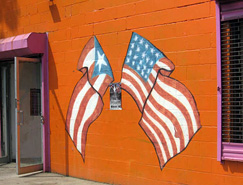recent arrivals
Puerto Rican Communities in the Valley
The United States gained sovereignty over Puerto Rico as a consequence of the Spanish-American War in 1898. The U.S. appointed governors to oversee the "unincorporated territory," and the bulk of Puerto Rican exports — primarily sugar, tobacco and coffee — went to the U.S. The Jones Act of 1917 granted residents of Puerto Rico U.S. citizenship, implemented universal male suffrage, and created an elected legislature. In 1951, the U.S. Congress granted Puerto Rico the right to draft its own constitution, and in 1952 Puerto Rico became a self-governing commonwealth of the U.S. Puerto Rico's commonwealth status was re-affirmed through plebiscites in 1967, 1991, 1993, and 1998, despite vigorous campaigning by other parties supporting independence and statehood.
About 90,000 Puerto Ricans moved to the continental United States between 1898 and 1944. Most settled in a few New York City neighborhoods. A sharp decline in Puerto Rico's agricultural economy during the Great Depression combined with the displacement of rural workers by intensive industrialization after World War II produced a mass exodus of more than half a million during the 1940s and 1950s. New communities were established in Springfield and Holyoke, Massachusetts, as Puerto Rican migrants moved north in search of employment in seasonal agriculture and blue-collar industries, and more affordable housing than was available in New York. Many settled in neighborhoods once populated by other ethnic groups such as the Irish, Italians, and Jews.
Because many of the mid-century immigrants were young, unskilled rural workers, with little education and knowledge of the English language, the experience of first-generation Puerto Ricans was similar to earlier immigrants arriving under similar conditions. Often excluded from jobs, housing and schools, they struggled at the lower end of the U.S. economy. The civil rights movement led to slowly improving conditions for all minority groups, however, and Latinos benefited from expanded bilingual education programs, political mobilization, and new laws prohibiting discrimination in employment. Furthermore, the relative ease of travel between Puerto Rico and the mainland created a unique "revolving-door" migration pattern as Puerto Ricans moved back and forth depending on the deterioration or improvement of living conditions and employment opportunities.
The Puerto Rican population of the Connecticut River Valley has grown steadily since the 1980s, making Springfield and Holyoke into regional centers of Latino culture and opportunity. The Valley draws Spanish-speaking immigrants from abroad and from larger cities such as Boston and New York. Skilled professionals, educators, lawyers and doctors are part of a growing Latino middle class. Hispanic Chambers of Commerce have promoted an increase in Latino-owned businesses that generate tax revenues, provide employment, and create wealth within local communities. Latino-run restaurants, beauty salons, florists, music shops and clothing boutiques have revitalized economically-depressed urban neighborhoods. Latino candidates contend for elective posts on city councils and school committees and represent the Valley in state government. Catholic and Protestant churches conduct services in Spanish. Parades and cultural festivals celebrate Puerto Rican life in the Valley, while neighborhood associations and educational facilities serve residents and new immigrants alike. Spanish-language newspapers, radio and television reflect the influence that tens of thousands of Puerto Ricans and other Latin American immigrants have here.
Citizenship status and the proximity of Puerto Rico, combined with a rich cultural heritage, helped sustain Puerto Rican immigrants in the Connecticut River Valley. The Spanish language remains a key component of Puerto Rican identity, facilitating cohesiveness within local communities and supporting the growth of services and businesses oriented toward the Latino population. Puerto Ricans on the mainland have created a distinctive community that spans generations and political borders and is continually renewed through extended-family and regional networks. The strong Latin-Caribbean flavor of many neighborhoods throughout the Connecticut River Valley attests to the vitality of Puerto Rican culture, and illustrates the rich variety that characterizes U.S. society.